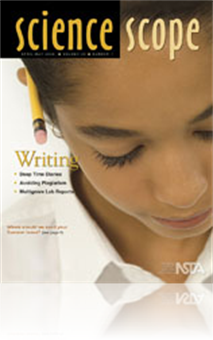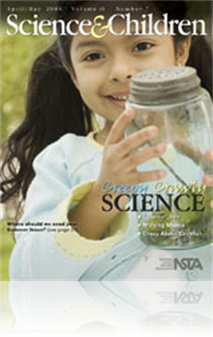All Resources
Journal Article
A Fifth Grader's Guide to the World
The challenge for today's elementary teachers is not whether but rather how to use computers to effectively teach students essential skills and concepts. One exciting way of meeting this challenge is to use Geographic Information Systems (GIS), comp...
Journal Article
Assessing Student Understanding with Technology
Most science teachers are amazed when grading tests and quizzes, often wondering how and why students have reached a conclusion, particularly when students fail to provide a detailed account of their logic. Ideally, a variety of assessments should be...
Journal Article
Research and Teaching: Active Learning Is Not Enough
In this article, the author examines the frequency of assessment and how it impacts learning in an undergraduate biology course employing a student-centered, active learning pedagogy. Frequent assessment was associated with better student performanc...
Journal Article
Turning the Potential Liability of Large Enrollment Laboratory Science Courses Into an Asset
Data sharing among multiple lab sections increases statistical power of data analyses and informs student-generated hypotheses. This article describes how to collect, organize, and manage data to support replicate and rolling inquiry models, with th...
Journal Article
Information Literacy in Introductory Biology
Incorporating information literacy exercises into the science curriculum will help students to navigate through the myriad of information available in different formats, and to become better scientific thinkers and writers. Here we describe how we i...
Journal Article
Capturing Student Interest in Astrobiology Through Dilemmas and Paradoxes
Astrobiology is an interdisciplinary science course that combines essential questions from life, physical, and Earth sciences. An effective astrobiology course also capitalizes on students' natural curiosity about social science implications of stud...
Journal Article
The Case Study: Assessment of Case Study Teaching -- Where Do We Go From Here? Part II
It is natural for faculty to select paradigms with which they have familiarity, and in the sciences, measurement is a careful, precise aspect of the research method. In science there has been a bias towards counting. However, measurement is not as ...
Journal Article
Undergraduate biology programs are currently undergoing reform to involve students in biomedical research. Engaging students in more active, hands-on experiments allows students to discover scientific principles for themselves, and to develop techni...
Journal Article
A new program, On Recent Discoveries by Emory Researchers (ORDER), has been developed as a bridge across the ever-widening gap between graduate and undergraduate education in the sciences. This bridge is created by merging the needs of graduate/post...
Journal Article
Introducing Evolution Using Online Activities in a Nonmajor Biology Course
Effective virtual education requires activities that promote application of scientific thinking skills, elaboration of research questions, hypothesis proposal, experimental design, and result presentation in a collaborative environment. Blackboard i...
Journal Article
Blogs: Applications in Science Education
Blogs are reshaping our political, social, and cultural environment. Education is affected by blogs because of their potential for learning and teaching, and also their risks. This article elaborates on a set of rules for evaluating and implementin...
Journal Article
Editorial: The Terman Oscillation
Lewis Terman's ghost is everywhere. He's present in spirit in every SAT score, every curriculum reassessment, and in every curriculum policy change. Terman is the Stanford, in Stanford-Binet, one of the first and most long-standing tests of human i...
Journal Article
The Effectiveness of Online Homework in an Introductory Science Class
Does the use of an online homework system such as WebAssign in an introductory astronomy course affect student performance? Four sections of introductory astronomy were compared in various homework situations, from no graded homework to graded homew...
Journal Article
Helping Students Write About Science Without Plagiarizing
Most students don't plagiarize just because they are lazy. Most of them simply do not know how to write about science. As teachers, we can use planning strategies to help make some of the process of writing automatic, which frees working memory to fo...
Journal Article
Using Interactive Science Notebooks for Inquiry-Based Science
Tired of finding students' work overflowing from the garbage can on the last day of school? Try using an Interactive Science Notebook approach to help students make connections to their learning. This approach emphasizes the process of focusing, expl...
Journal Article
Most students are unaware of the process of molting, but it is an animal characteristic they're sure to be interested in and should have the opportunity to observe. Through a two-month long unit on animal molting, kindergarteners observed pill bugs,...
Journal Article
A second-grade class follows honeybees throughout the season in this integrated study which explores the relationship between honeybees and fruit trees They cover life cycles, bee and plant anatomy, and seasons. This article highlights those teachi...
Journal Article
Methods and Strategies: The Cricket Crew
Four girls intrigued by cricket play during their recess spawn a cricket epidemic at their school and homes as they turn inquiry into an entire project proposal for cricket research. Both student and parent directed, teachers committed to finding w...
Journal Article
Send Your Students to MARS for Their Next Research Project
Alleviate the fear often associated with research papers through this interdisciplanary project that incorporates community support and technology into a fascinating discovery of the planet Mars....
Journal Article
Instead of having students read about biomes in a textbook, why not have them become expert biogeographers? Once students have learned what a biogeographer does through an on-line search, they will take on the role as expert biogeographer. In this hy...
Journal Article
Commentary: Science in Structure
Science learning does not have to stop at the classroom door. A well-designed construction project takes as many opportunities as possible to give students additional scientific stimulation. A periodic table on the ceiling of a chemistry lab/classroo...
Journal Article
Partners in Crime: Integrating Forensic Science and Writing
Partners is Crime is a project-based initiative, funded by various sources, including the Toyota Tapestry grant, which strives to keep education interesting while closing the achievement gap through collaborations with other teachers and members of t...
Journal Article
Ask the Experts -- April/May 2006
The Experts address this thought-provoking question in this month's column: "How does the air quality, specifically the level of air pollutants, in the smoking section of a restaurant compare to air quality in smoke-free restaurants?"...
Journal Article
Idea Bank: Inquiry and the Collapsing Can
The Collapsing Can demonstration has reached classic status for illustrating pressure and properties of gases for students of all ages. But how effective is this demonstration for promoting learning? How can it be converted from simply a dramatic eve...
Journal Article
Scope on the Skies: Solar system update
Our knowledge of the solar system and of orbital dynamics has undergone some changes as telescope technology improved. This month's Scope on the skies discusses the newest developments within the solar system and redefines the meaning of the word "pl...








